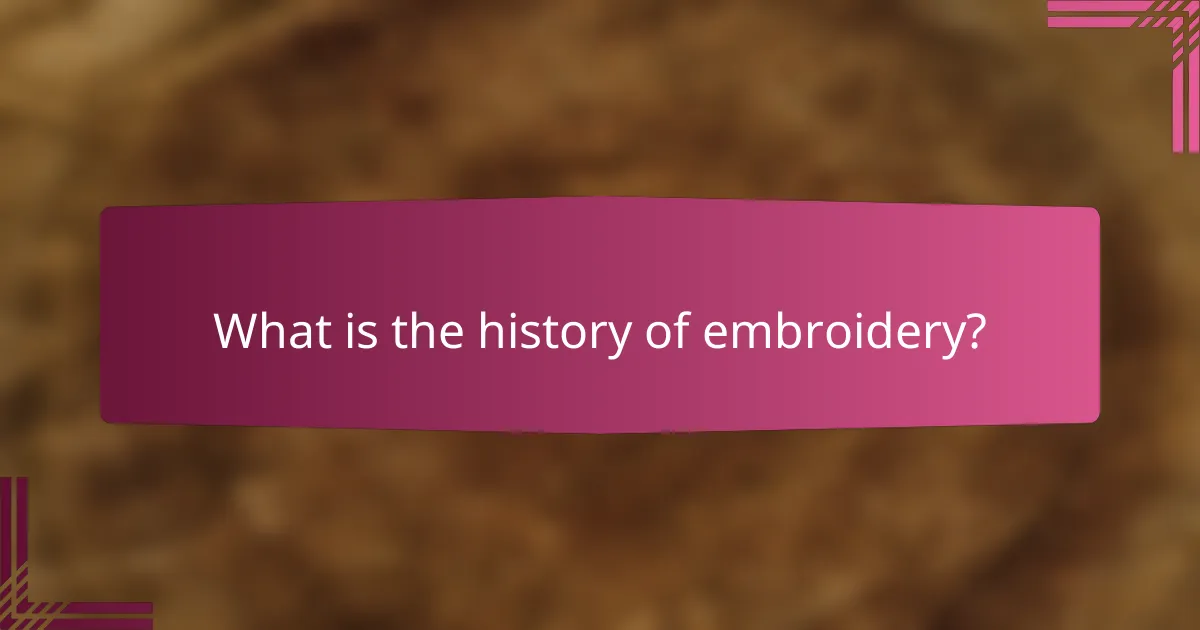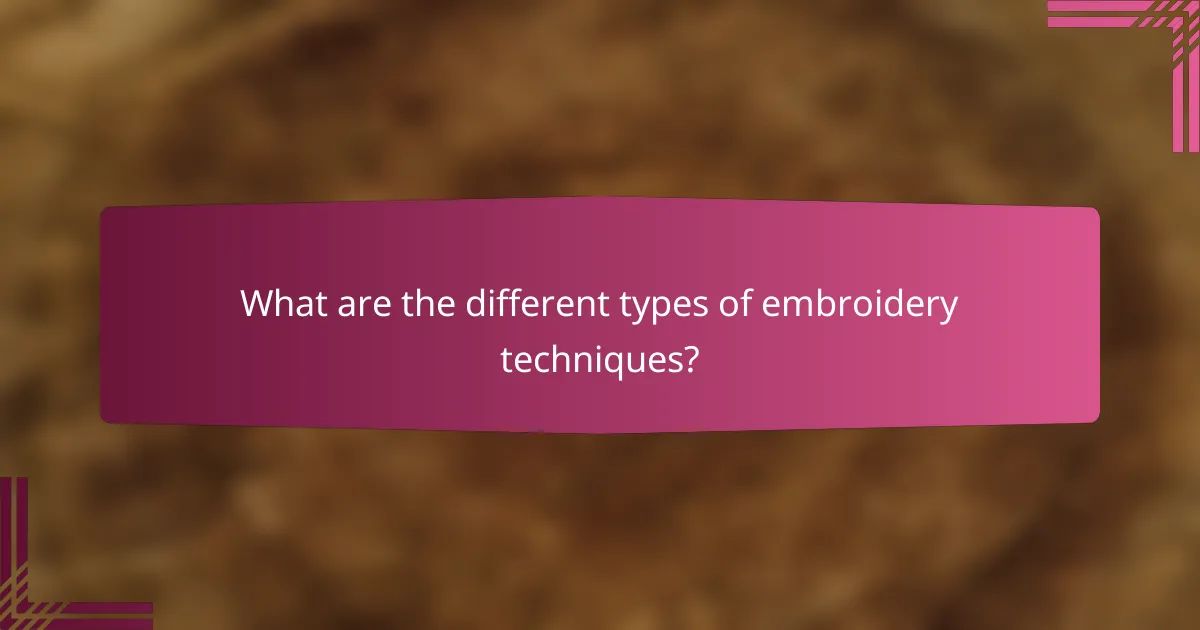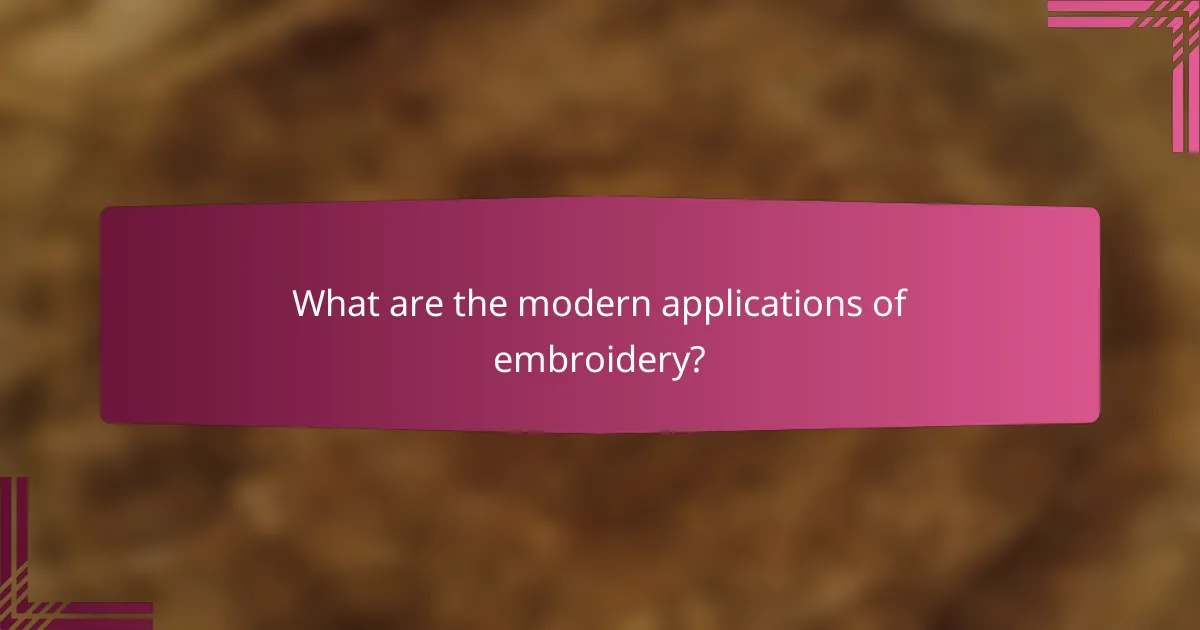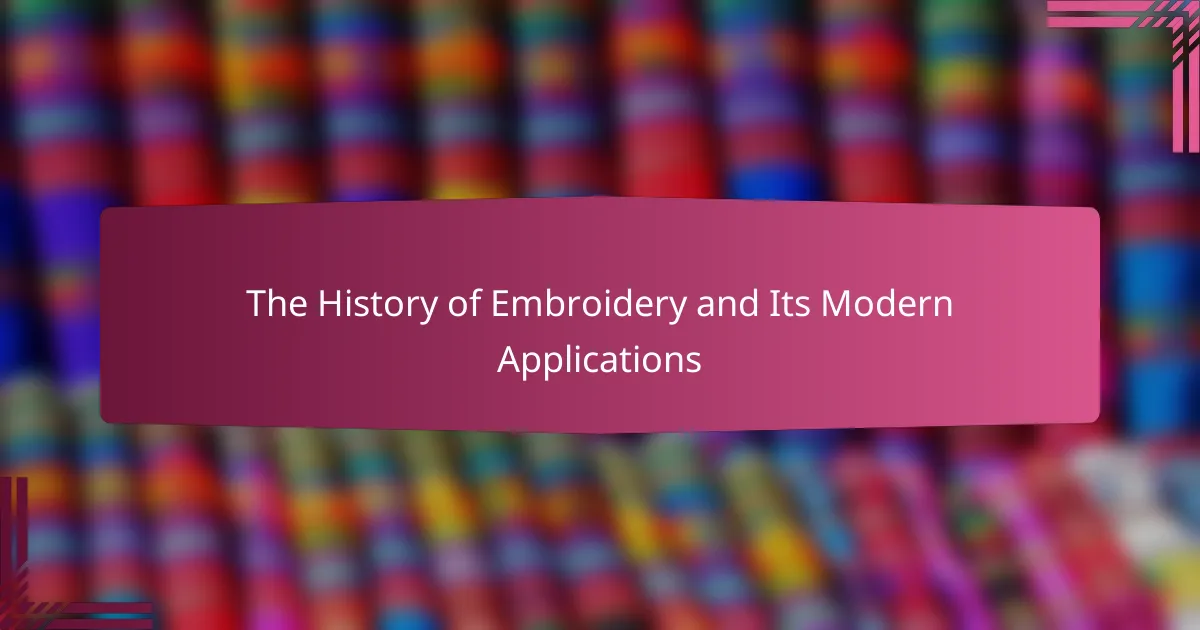
What is the history of embroidery?
Embroidery has a rich history dating back thousands of years. Its origins can be traced to ancient civilizations such as Egypt and China. Archaeological findings show that embroidered textiles were used as early as 5000 BC. In ancient Egypt, embroidery was often used for ceremonial garments and burial shrouds. The craft spread through trade routes, influencing various cultures. By the Middle Ages, embroidery became a popular art form in Europe. It was used to adorn clothing, tapestries, and [censured] vestments. The introduction of embroidery machines in the 19th century revolutionized the craft. Today, embroidery continues to evolve with modern techniques and technologies.
How did embroidery originate and evolve over time?
Embroidery originated in ancient times as a decorative art form. It began with simple stitching techniques used to embellish clothing and textiles. The earliest examples date back to the 3rd century BC in China, where silk embroidery flourished. Over time, embroidery spread across cultures, with each region developing unique styles and techniques. In medieval Europe, embroidery became a symbol of wealth and status, often featuring intricate designs. The invention of the sewing machine in the 19th century revolutionized embroidery production, making it more accessible. Today, embroidery combines traditional methods with modern technology, including machine and digital embroidery. This evolution reflects cultural exchanges and innovations throughout history.
What are the earliest known examples of embroidery?
The earliest known examples of embroidery date back to the 3rd century BC. Archaeological findings from ancient China reveal embroidered textiles that showcase intricate designs. These pieces were often made using silk and featured motifs like flowers and animals. Additionally, ancient Egyptian tombs have uncovered embroidered items dating to around 1000 BC. These artifacts highlight the significance of embroidery in cultural and religious practices. The use of embroidery in these early civilizations demonstrates its historical importance and artistic value.
How have cultural influences shaped embroidery techniques?
Cultural influences have significantly shaped embroidery techniques across different regions. Various countries have developed unique styles based on their traditions and available materials. For instance, Chinese embroidery often features intricate designs and symbolism, reflecting cultural values. In contrast, Indian embroidery techniques like Zardozi incorporate gold threads, showcasing the country’s rich textile heritage.
Historical events also impacted embroidery styles. The Silk Road facilitated the exchange of techniques and patterns between cultures. This led to hybrid styles, such as Persian embroidery, which combines elements from various traditions. Regional motifs often represent local flora and fauna, further embedding cultural identity into the craft.
Additionally, religious beliefs have influenced motifs and techniques. For example, Islamic embroidery often avoids human figures, focusing instead on geometric patterns. This adherence to cultural norms shapes the aesthetics of embroidery within different communities. Overall, cultural influences contribute to the diversity and evolution of embroidery techniques worldwide.
What are the major historical milestones in embroidery?
Embroidery has several major historical milestones. The earliest evidence dates back to 30,000 BC in the form of decorative stitching on clothing found in ancient burial sites. In ancient Egypt, around 3000 BC, intricate embroidery was used to embellish garments for the elite. During the Middle Ages, embroidery became a prominent art form in Europe, with the establishment of guilds dedicated to its craft. The introduction of the embroidery machine in the 19th century revolutionized the industry, making designs more accessible. In the 20th century, embroidery saw a revival in folk art movements, emphasizing handmade techniques. Today, embroidery combines traditional methods with modern technology, reflecting its enduring significance in fashion and art.
How did embroidery spread across different regions?
Embroidery spread across different regions primarily through trade routes and cultural exchanges. As societies interacted, they shared techniques and designs. The Silk Road facilitated the movement of embroidered textiles between Asia and Europe. Maritime routes also contributed to the spread of embroidery as seafaring nations exchanged goods. Colonization introduced new embroidery styles to various regions. Additionally, migration brought diverse embroidery traditions to new areas. The rise of the printing press increased the availability of embroidery patterns. This allowed for standardized designs to circulate widely. Each region adapted techniques to fit local tastes and materials.
What role did embroidery play in historical societies?
Embroidery played a significant role in historical societies as a form of artistic expression and cultural identity. It served as a means of beautifying clothing and household items. Many societies used embroidery to convey social status and wealth. For instance, in ancient China, intricate embroidery was a symbol of nobility. In medieval Europe, embroidered garments indicated rank and profession. Embroidery also functioned as a storytelling medium, depicting historical events and myths. Additionally, it was a way for women to engage in creative work and contribute to their households. The skills required for embroidery were often passed down through generations, preserving cultural heritage.

What are the different types of embroidery techniques?
There are several different types of embroidery techniques. Common techniques include cross-stitch, satin stitch, and chain stitch. Cross-stitch involves forming an ‘X’ shape with thread on a fabric grid. Satin stitch is characterized by flat, smooth stitches that fill areas. Chain stitch creates a looped pattern resembling a chain. Other techniques include crewel, which uses wool for intricate designs, and blackwork, known for its use of black thread on white fabric. Each technique has unique applications and historical significance in embroidery art.
How do traditional embroidery techniques differ from modern ones?
Traditional embroidery techniques focus on hand-stitching methods using natural fibers and dyes. These methods often emphasize cultural patterns and motifs unique to specific regions. In contrast, modern embroidery techniques frequently utilize machine stitching and synthetic materials. This shift allows for mass production and greater uniformity in designs. Traditional techniques often require extensive skill and time investment, while modern methods prioritize efficiency and speed. Historical records show that traditional embroidery dates back thousands of years, reflecting the craftsmanship of artisans. Modern embroidery, however, has evolved significantly since the Industrial Revolution, integrating technology into the art form.
What are the key characteristics of hand embroidery?
Hand embroidery is characterized by its intricate designs created using a needle and thread. It involves manual stitching techniques that allow for personal expression. Common stitches include satin, chain, and cross-stitch. Hand embroidery often features unique patterns and textures, differentiating it from machine embroidery. The process requires skill and patience, often resulting in one-of-a-kind pieces. Hand embroidery can be applied to various materials such as fabric, leather, and canvas. Its historical significance dates back thousands of years, showcasing cultural heritage. The revival of hand embroidery in modern crafts emphasizes its artistic value and therapeutic benefits.
What advancements have been made in machine embroidery?
Recent advancements in machine embroidery include improved technology and software. Modern machines now feature enhanced digitizing capabilities. These advancements allow for more intricate designs and faster production times. Additionally, the integration of artificial intelligence optimizes stitch quality. High-speed machines can achieve thousands of stitches per minute. Innovations in thread and fabric compatibility have expanded design possibilities. Moreover, user-friendly interfaces make machine operation more accessible. These developments have revolutionized the embroidery industry, increasing efficiency and creativity.
What are the popular styles of embroidery around the world?
Popular styles of embroidery around the world include cross-stitch, satin stitch, and crewel work. Cross-stitch is characterized by its X-shaped stitches forming a grid pattern. It is a traditional technique often used in folk art. Satin stitch involves flat, smooth stitches that create a polished look, commonly seen in decorative motifs. Crewel work uses wool thread for intricate designs and is known for its textured finish. Other notable styles include kantha from India, which utilizes running stitches for quilting, and sashiko from Japan, featuring geometric patterns. Each style reflects cultural heritage and artistic expression.
How do regional styles influence embroidery patterns?
Regional styles significantly influence embroidery patterns by dictating design elements, color schemes, and techniques. Each region has its own cultural heritage and traditions that shape these patterns. For example, floral motifs are prevalent in European embroidery, while geometric designs are common in Middle Eastern styles. Additionally, local materials and available dyes affect color choices in embroidery. Historical events, such as trade routes, also introduce new patterns and techniques across regions. Specific regions may develop unique stitches that are characteristic of their embroidery style, like the cross-stitch in Eastern Europe. These regional influences create a rich tapestry of diverse embroidery patterns globally.
What is the significance of embroidery in cultural identity?
Embroidery plays a crucial role in cultural identity. It serves as a medium for expressing traditions and values. Various cultures use unique patterns and techniques in their embroidery. For example, indigenous communities often incorporate symbols that reflect their history. These designs can signify social status, community belonging, or spiritual beliefs. Research shows that embroidery can foster a sense of pride and continuity within a culture. Additionally, it often transmits knowledge of craftsmanship across generations. The significance of embroidery is evident in its ability to connect individuals to their heritage.

What are the modern applications of embroidery?
Modern applications of embroidery include fashion design, home decor, and branding. In fashion, embroidery enhances garments with intricate designs. It adds texture and personalization to clothing items. Home decor uses embroidery for decorative pillows, wall hangings, and table linens. Branding incorporates embroidery in creating logos on uniforms and promotional items. The rise of digital embroidery technology has increased efficiency and creativity in these applications. Custom embroidery services are widely available, catering to individual and business needs. These applications showcase the versatility and enduring appeal of embroidery in contemporary culture.
How is embroidery used in fashion today?
Embroidery is used in fashion today as a prominent decorative technique. It enhances garments, accessories, and footwear with intricate designs. Designers incorporate embroidery to add texture and visual interest. This technique is often seen in both high-end and streetwear collections. Embroidered pieces can convey cultural significance or personal expression. Many brands utilize machine embroidery for efficiency and precision. Hand-stitched embroidery remains valued for its artisanal quality. The global fashion industry increasingly embraces sustainable practices, often using embroidery to repurpose and upcycle materials.
What impact does embroidery have on contemporary clothing design?
Embroidery significantly enhances contemporary clothing design. It adds texture, depth, and visual interest to garments. Designers utilize embroidery to create unique patterns and intricate details. This technique allows for personalization and customization in fashion. According to a 2021 study by Fashion Institute of Technology, embroidered pieces often command higher prices due to their craftsmanship. Additionally, embroidery can convey cultural narratives and artistic expressions. Its revival in modern fashion reflects a growing appreciation for artisanal skills. Overall, embroidery plays a crucial role in elevating contemporary clothing aesthetics.
How do brands incorporate embroidery into their products?
Brands incorporate embroidery into their products by using it as a decorative technique to enhance aesthetics. This technique adds texture and visual interest to garments and accessories. Many brands utilize embroidery for branding purposes, such as logos and slogans. Customization options allow consumers to personalize items with their designs. Additionally, embroidery can be applied to various materials, including fabric, leather, and denim. This versatility makes it suitable for diverse product categories like apparel, home textiles, and promotional items. The global embroidery market was valued at approximately $3 billion in 2020, indicating its popularity in the fashion industry. Brands often collaborate with skilled artisans to create intricate designs, ensuring high-quality craftsmanship.
What are the practical uses of embroidery in home decor?
Embroidery has several practical uses in home decor. It enhances aesthetic appeal through decorative wall hangings. Embroidered cushions offer comfort and style to living spaces. Table linens featuring embroidery add elegance to dining experiences. Curtains with embroidered designs can create a unique ambiance. Embroidery can personalize items, making them special and unique. It is also used in creating custom artwork for homes. Additionally, embroidered patches can be applied to furniture for a distinctive touch. Overall, embroidery serves both functional and decorative purposes in home decor.
How can embroidery enhance interior design?
Embroidery can enhance interior design by adding texture, color, and personalization to spaces. It serves as a versatile decorative element that can transform various surfaces. Embroidered textiles can be used for cushions, curtains, and wall hangings. These items introduce unique patterns and designs that reflect individual style. Additionally, embroidery can evoke a sense of warmth and comfort in a room. Historical applications show that embroidered items have been used for centuries in various cultures. For example, traditional embroidered tapestries were common in medieval Europe for both aesthetics and insulation. This rich history underscores the enduring appeal of embroidery in modern interior design.
What are common embroidery projects for home decor?
Common embroidery projects for home decor include wall hangings, pillow covers, and table runners. These projects enhance the aesthetic of living spaces. Wall hangings can feature intricate designs or personalized motifs. Pillow covers often incorporate patterns that complement the room’s color scheme. Table runners add a decorative touch to dining areas. Other projects include embroidered curtains and fabric art. Each project allows for creativity and personalization in home decor. Embroidery has been a popular craft for centuries, used to embellish everyday items.
What tips can help beginners get started with embroidery?
Start with basic supplies like fabric, thread, and needles. Choose a simple design to practice on. Learn basic stitches such as running stitch and backstitch. Use an embroidery hoop to keep fabric taut. Practice regularly to improve your skills. Explore online tutorials for visual guidance. Join embroidery groups for support and inspiration. Keep your workspace organized for efficiency.
The main entity of this article is embroidery, a decorative art form with a rich history that dates back thousands of years, originating in ancient civilizations such as Egypt and China. The article explores the evolution of embroidery techniques, significant historical milestones, and the cultural influences that have shaped its practice across different regions. It also highlights the modern applications of embroidery in fashion and home decor, detailing various techniques and styles, as well as practical tips for beginners. Overall, the content provides a comprehensive overview of embroidery’s historical significance and its contemporary relevance.
